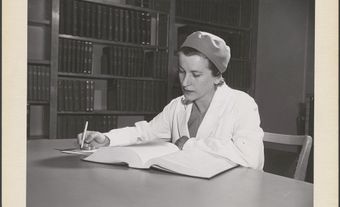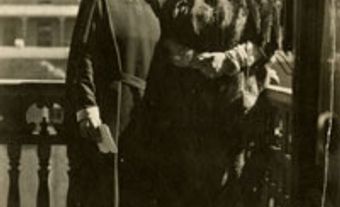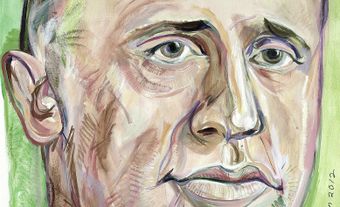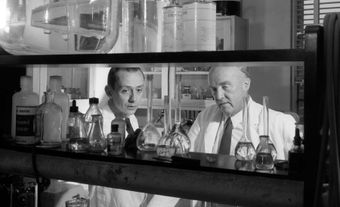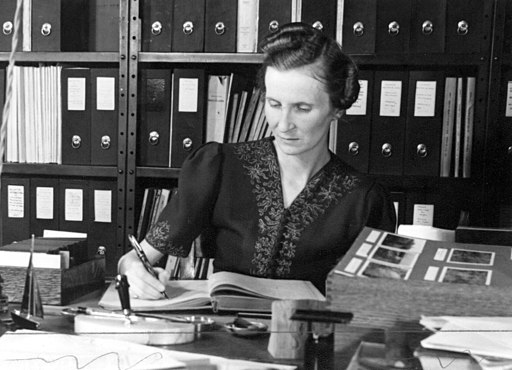
Childhood in Montreal and Early Studies
Marcelle Gauvreau spent the first two years of her life in Rimouski, in a neo–Queen-Anne–style house from which her father also ran his medical practice. Dr. Joseph Gauvreau built the house for his large family. Dr. Gauvreau was a nationalist and an ardent defender of the French language known for his interest in nature, hygiene and preventative medicine. Among Marcelle Gauvreau’s large group of siblings (five girls and five boys), the best known are Jean-Marie, founder of the École du meuble de Montréal, and Louis, a furniture designer. Additionally, Gauvreau’s nephew was the renowned doctor and director Claude Jutra, the son of her sister Rachel and radiologist Albert Jutras.
Gauvreau moved to Montreal in 1909 and studied at the Académie Saint-Urbain, run by the sisters of the Congregation of Notre Dame (CND), and at the Académie du Boulevard, under the sisters of the Congregation of Saint Anne. During high school, Gauvreau boarded at the CND’s Mont-Sainte-Marie convent. In 1917, her father bought a country house in Rivière-Beaudette. It was there that her love of nature was awakened and that she recovered after being afflicted by polio when she was very young and later by tuberculosis before her university studies.
University Studies and Early Career
After recovering from her illness, Gauvreau was finally able to pursue her studies in literature and philosophy at the Université de Montréal in 1929. In the fall of 1930, a herbarium that she designed did well in a botany contest run by the Devoir, but because Gauvreau was no longer a high school student, she was excluded from the contest. Gauvreau then shifted her focus to the natural sciences and enrolled at the Université de Montréal’s Institut de botanique, of which Frère Marie-Victorin was the director. There Gauvreau obtained a certificate in general botany, followed by a certificate in systematic botany in 1932. Gauvreau received her licentiate in natural sciences in 1933. She then took courses in zoology, pedagogy for the natural sciences, paleobotany, economic botany, general biology and floristics.
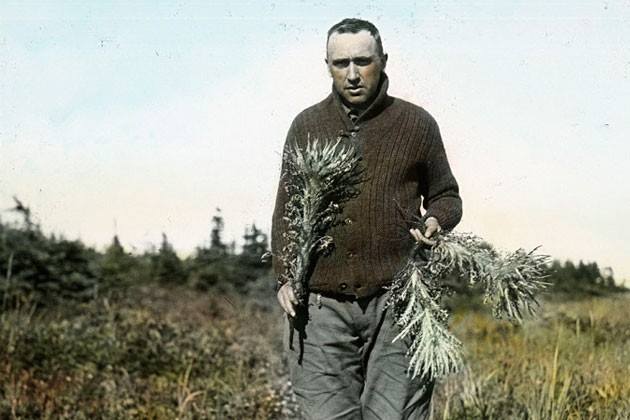
Gauvreau started her career by becoming the first librarian at the Institut de botanique. Frère Marie-Victorin asked her to catalogue the documents in the Institut de botanique’s library, so she attended the McGill University Library School, earning her diploma in science librarianship in 1935. Gauvreau also participated in the publication of Marie-Victorin’s La Flore laurentienne. In 1933, she edited the text and wrote the index and the glossary, tasks that she also carried out for Marie-Victorin’s three-volume Itinéraires work. In addition, Gauvreau worked as an assistant at the Institut de botanique.
Her interest in nature also led Gauvreau to take an astronomy course in 1950.
Specialization as a Botanist
One of the pioneers early in the scientific era and French Canada’s first graduate with a master’s of science degree, Gauvreau specialized in marine algae found in the St. Lawrence River and at its mouth. Her research took her to the Îles de la Madeleine (Magdalen Islands), the Gaspé Peninsula, Saguenay, the Charlevoix region, Minganie, New Brunswick, Nova Scotia and Prince Edward Island. Gauvreau’s thesis supervisor was Jules Brunel. She also made numerous trips to the United States and Europe to round out her studies.
Teaching
At the beginning, Gauvreau shared her knowledge with religious educators, including the sisters of the Congregation of Jesus and Mary of Canada and the United States (at the Collège de Sillery in Quebec City) and the sisters of the CND (at the Institut de pédagogie familiale run by the Sisters of the Holy Names of Jesus and Mary in Outremont). Gauvreau also taught summer courses to teachers at the Institut de botanique. Throughout her life, she was an educator to all kinds of learners: small children, students young and old, adults and teachers.
Founding and Administration of the École de l’Éveil
Founded in 1935, the École de l’Éveil was a school that introduced students aged 4 to 7 to natural history by developing their sense of observation. For the first four years, the school was run out of a room at the Hotel Pennsylvania on Saint-Denis Street, across from the Université de Montréal. Then, beginning in the summer of 1939, the school was housed at the Jardin botanique (Botanical Garden) as part of its Educational Service. Gauvreau’s brothers were in charge of furnishing the school: Louis drew up the plans and Jean-Marie carried them out. The school moved to the Institut Cardinal-Léger in 1957 and to the Fédération nationale Saint-Jean-Baptiste on Sherbrooke Street in 1965. Gauvreau gave courses throughout the province and opened satellites of the school in Ville d’Anjou, Duvernay, Rivière-des-Prairies, Rosemont and Saint-Léonard. Students aged 7 to 10 also took her courses. The École de l’Éveil helped democratize scientific knowledge but closed upon the death of its founder.
Work as a Communicator
From 1933 to 1944, Gauvreau was one of the first women to present the results of her research to the Association canadienne-française pour l’avancement des sciences (Acfas). From 1941, on the educational Société Radio-Canada (SRC) program Radio-Collège, she produced some segments for the La cité des plantes series. In 1943, in the guise of the Fée des fleurs (Fairy of the Flowers), Gauvreau told fictional stories for children and the young at heart on the SRC’s radio service three times a week. Gauvreau also was also a commentator on many radio programs, including Le Réveil rural and Fémina, and appeared on television in Merveilles de la nature, for which she also worked as a researcher.
For eight years, Gauvreau wrote the Cercles des jeunes naturalistes’s monthly column in L’oiseau bleu, a magazine published by the Société Saint-Jean-Baptiste de Montréal. From 1938 to 1954, she wrote a weekly article on botany for the newspaper Le Devoir. Gauvreau published three books popularizing science for the very young as sole author, two books in collaboration with others, and ten brochures. She penned 267 articles for various newspapers and magazines including L’Intérim, L’Action catholique, L’Écho du Bas-Saint-Laurent, L’Éclaireur, L’Enseignement primaire, L’oiseau bleu, Bibliothèque des jeunes naturalistes, La Famille, La Presse, La Province, La Voix nationale, Bulletin des Sociétés de géographie de Québec et de Montréal, Le Devoir, Le Droit, Le Quartier latin, Annales de l’ACFAS, Paysana and Regard. In total, she wrote about 400 documents, in addition to translating and adapting two volumes on the flora and fauna of Canada. The many talks she delivered charmed audiences as numerous as they were varied.
Relationship with Frère Marie-Victorin
In the beginning, Frère Marie-Victorin was Gauvreau’s mentor, but between these two tuberculosis survivors there grew a closeness that was evident to those around them. Through the years, Gauvreau moved from being Marie-Victorin’s close collaborator to his confidante. Some even spoke of love. From 1933 to 1944, Gauvreau carried on an epistolary relationship with Marie-Victorin, which led to the publication of Lettres biologiques: recherches sur la sexualité humaine. The two researchers exchanged views on various subjects. She aided in his sexuality research, which was based on his encounters with Cuban sex workers, by teaching him, among other things, about female desire.
This correspondence may seem astonishing. It should be remembered, however, that there was also an epistolary relationship between Cardinal Karol Wojtyła, Archbishop of Krakow and future Pope John Paul II, with the Polish-born, married, American philosopher Anna-Teresa Tymieniecka — a relationship of thirty years that he himself characterized as being an “intense friendship.” Frère Marie-Victorin intimated many times how the obligation of chastity was an insurmountable trial and how it was necessary to reconcile sexuality and religion. The Lettres biologiques represent an important contribution to the history of sexuality in Quebec and of religious life.
Awards and Honours
- Award, Association canadienne-française pour l’avancement des sciences (Acfas) (1939)
- Medal, Association canadienne des bibliothécaires pour enfants (for Plantes vagabondes) (1961)

 Share on Facebook
Share on Facebook Share on X
Share on X Share by Email
Share by Email Share on Google Classroom
Share on Google Classroom
